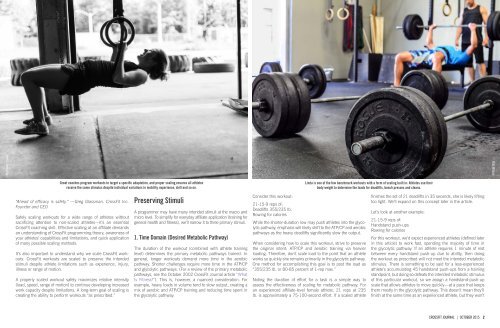SCALING CROSSFIT WORKOUTS
2mmo3pwZQ
2mmo3pwZQ
- No tags were found...
Create successful ePaper yourself
Turn your PDF publications into a flip-book with our unique Google optimized e-Paper software.
Andreane Fraser<br />
Rob Wilson<br />
Great coaches program workouts to target a specific adaptation, and proper scaling ensures all athletes<br />
receive the same stimulus despite individual variations in mobility, experience, skill and so on.<br />
Linda is one of the few benchmark workouts with a form of scaling built in: Athletes use their<br />
body weight to determine the loads for deadlifts, bench presses and cleans.<br />
“Ahead of efficacy is safety.” —Greg Glassman, CrossFit Inc.<br />
Founder and CEO<br />
Safely scaling workouts for a wide range of athletes without<br />
sacrificing attention to non-scaled athletes—it’s an essential<br />
CrossFit coaching skill. Effective scaling at an affiliate demands<br />
an understanding of CrossFit programming theory, awareness of<br />
your athletes’ capabilities and limitations, and quick application<br />
of many possible scaling methods.<br />
It’s also important to understand why we scale CrossFit workouts:<br />
CrossFit workouts are scaled to preserve the intended<br />
stimuli despite athlete limitations such as experience, injury,<br />
illness or range of motion.<br />
A properly scaled workout safely maximizes relative intensity<br />
(load, speed, range of motion) to continue developing increased<br />
work capacity despite limitations. A long-term goal of scaling is<br />
creating the ability to perform workouts “as prescribed.”<br />
Preserving Stimuli<br />
A programmer may have many intended stimuli at the macro and<br />
micro level. To simplify for everyday affiliate application (training for<br />
general health and fitness), we’ll narrow it to three primary stimuli.<br />
1. Time Domain (Desired Metabolic Pathway)<br />
The duration of the workout (combined with athlete training<br />
level) determines the primary metabolic pathways trained. In<br />
general, longer workouts demand more time in the aerobic<br />
pathway. Shorter challenges require more time in the ATP/CP<br />
and glycolytic pathways. (For a review of the primary metabolic<br />
pathways, see the October 2002 CrossFit Journal article “What<br />
Is Fitness?”). This is, however, a nuanced consideration. For<br />
example, heavy loads in volume tend to slow output, creating a<br />
mix of aerobic and ATP/CP training and reducing time spent in<br />
the glycolytic pathway.<br />
Consider this workout:<br />
21-15-9 reps of:<br />
Deadlifts 355/235 lb.<br />
Rowing for calories<br />
While the shorter-duration row may push athletes into the glycolytic<br />
pathway, emphasis will likely shift to the ATP/CP and aerobic<br />
pathways as the heavy deadlifts significantly slow the output.<br />
When considering how to scale this workout, strive to preserve<br />
the original intent: ATP/CP and aerobic training via heavier<br />
loading. Therefore, don’t scale load to the point that an athlete<br />
works so quickly she remains primarily in the glycolytic pathway.<br />
One method for accomplishing this goal is to post the load as<br />
“355/235 lb. or 80-85 percent of 1-rep max.”<br />
Noting the duration of effort for a task is a simple way to<br />
assess the effectiveness of scaling for metabolic pathway. For<br />
an experienced affiliate-level female athlete, 21 reps at 235<br />
lb. is approximately a 75-100-second effort. If a scaled athlete<br />
finishes the set of 21 deadlifts in 35 seconds, she is likely lifting<br />
too light. We’ll expand on this concept later in the article.<br />
Let’s look at another example:<br />
21-15-9 reps of:<br />
Handstand push-ups<br />
Rowing for calories<br />
For this workout, we’d expect experienced athletes (defined later<br />
in this article) to work fast, spending the majority of time in<br />
the glycolytic pathway. If an athlete requires 1 minute of rest<br />
between every handstand push-up due to ability, then doing<br />
the workout as prescribed will not meet the intended metabolic<br />
stimulus. There is something to be said for a less-experienced<br />
athlete’s accumulating 45 handstand push-ups from a training<br />
standpoint, but doing so defeats the intended metabolic stimulus<br />
of this particular workout, so we assign a handstand-push-up<br />
scale that allows athletes to move quickly—at a pace that keeps<br />
them mostly in the glycolytic pathway. This doesn’t mean they’ll<br />
finish at the same time as an experienced athlete, but they won’t<br />
<strong>CROSSFIT</strong> JOURNAL | OCTOBER 2015 2


